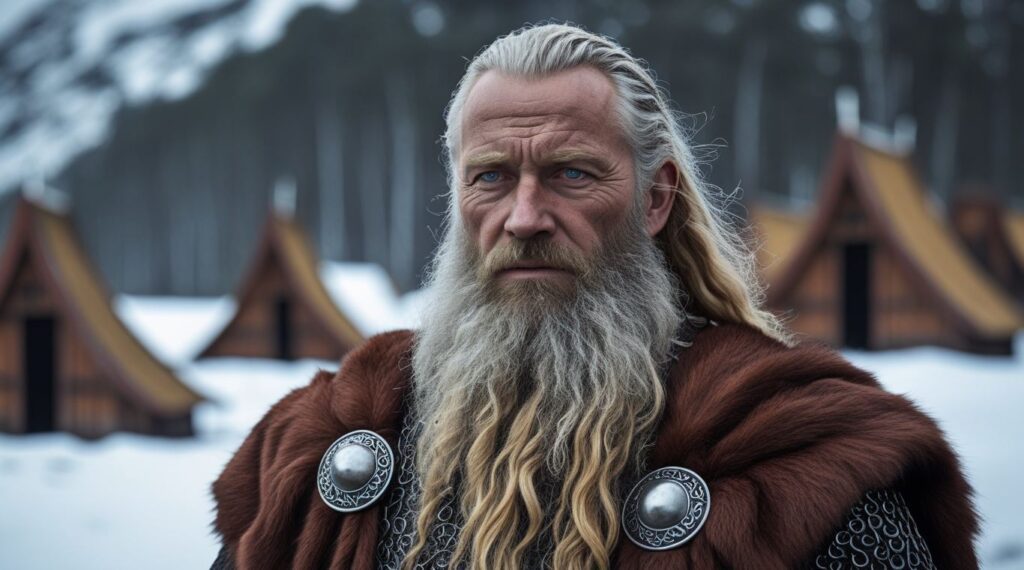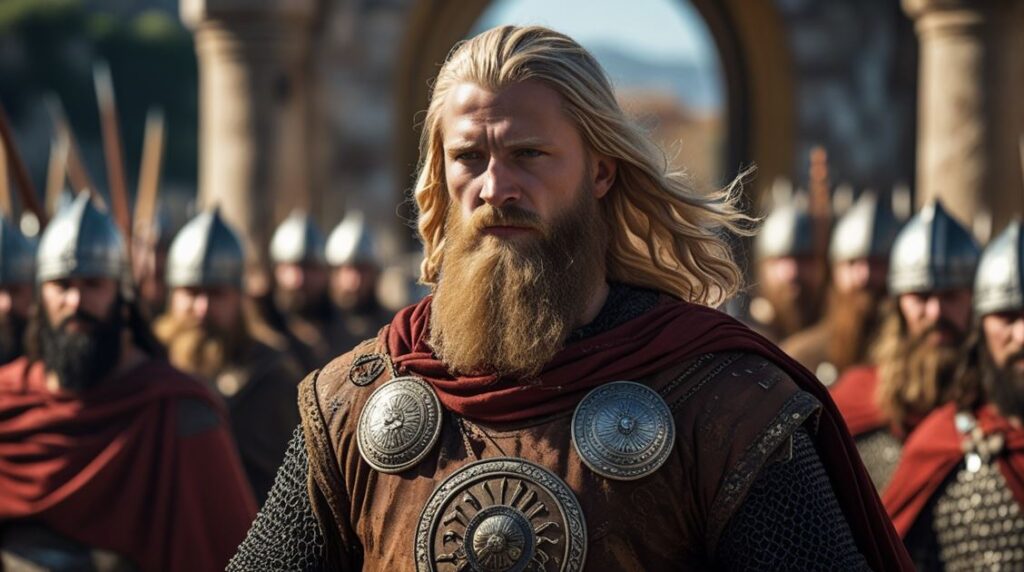At just 17 years old, Harald Sigurdsson fled Norway in disgrace after his half-brother’s death at the Battle of Stiklestad. Decades later, he would return as Harald Hardrada—one of medieval Europe’s most feared warrior-kings.
Most know Harald as the Norwegian ruler who died at Stamford Bridge in 1066, ending the Viking Age. But before that final gamble for the English crown, the teenage exile embarked on an extraordinary journey across medieval Europe, transforming himself from desperate refugee into legendary conqueror.
This is the story of how a penniless prince with nothing but ambition carved out his destiny in the golden courts of Kiev and the marble palaces of Byzantium—proving that in the medieval world, boldness could indeed win you an empire.
The Golden Court of Kiev
After his dramatic escape from the Battle of Stiklestad, young Harald Sigurdsson found himself in one of medieval Europe’s most fascinating crossroads – Kiev.
At barely 17 years old, this future king of Norway was about to receive his military education in the court of one of history’s most formidable rulers: Yaroslav the Wise.
Kiev in the 1030s was a marvel that would have taken Harald’s breath away.
With around 50,000 inhabitants, it dwarfed contemporary London and rivaled the great cities of the age. This was the beating heart of Kievan Rus, a loose confederation of Slavic and Norse territories that stretched across Eastern Europe.
The city’s lower town, called Podil, bustled with merchants trading everything from Baltic amber to Byzantine silk, from northern furs to human slaves.
But it was the upper city that truly impressed visitors. Massive ramparts crowned with white-painted oak palisades protected the inner citadel, accessed through three great gates – the Polish Gate, the Jewish Gate, and the magnificent Golden Gate, complete with its own chapel and gilded dome, deliberately modeled after Constantinople’s famous entrance.
Yaroslav the Wise: A Ruler Forged in Blood
The man who ruled this impressive realm was Yaroslav, a figure both terrifying and magnificent.
Known to later chroniclers as “the Wise” (though contemporaries called him “the Lame” due to a battle wound), Yaroslav had carved out his position through ruthless fraternal warfare.
He had many brothers, and had systematically eliminated most in his rise to power, including one who fled to Poland and died mad, stabbing at empty air while haunted by visions of his brother’s vengeance.
Yet Yaroslav was far more than a mere warlord.
This complex ruler represented the fascinating cultural fusion of his age – Viking by blood, Slavic by culture, and Roman by aspiration.
His father Vladimir the Great had converted to Christianity in 988, marrying the Byzantine Emperor’s daughter Anna, and Yaroslav continued this policy of looking both east and west.
He had just begun construction of his own Hagia Sophia cathedral, a deliberate echo of Constantinople’s great church.
A Young Viking’s Military Apprenticeship
Harald’s timing was perfect. Yaroslav welcomed Scandinavian mercenaries, and the young Norwegian quickly proved his worth.
For two crucial years, between the ages of 17 and 19, Harald served in the Grand Prince’s army, learning the craft of war in the forests and steppes of Eastern Europe.
The fragmentary records hint at campaigns against the Poles, who were pushing eastward from their base around Poznan into what is now Belarus and western Ukraine. Court poets later sang of how “the leaders fought side by side their troops in a fighting wedge, they drove the Slavs to defeat and showed the Poles little mercy.”
Even more challenging were the campaigns against the Pechenegs, the fearsome steppe nomads from Central Asia who had once beheaded Yaroslav’s grandfather and turned his skull into a gold-lined drinking cup. These horse warriors were nearly unbeatable on open ground, so the Rus forces would transport troops along rivers and try to draw the Pechenegs into forested terrain where their cavalry advantage was neutralized.
Harald excelled at this brutal form of warfare. By age 18 or 19, he had risen to captain of the guard – the elite Druzhina who feasted in the prince’s hall and enjoyed the company of slave girls assigned to serve them. But the young Norwegian had grander ambitions than a comfortable position in Kiev.
Love, Ambition, and Rejection
Harald’s eye had fallen on Yaroslav’s daughter, Elizabeth (called Ellisif in Norse). Yaroslav had other concerns when Harald formally requested her hand in marriage. He had initially been rejected because he was not yet wealthy enough
He needed wealth and reputation to win his bride and eventually reclaim his Norwegian throne. There was only one place where a ambitious young warrior could achieve both: Miklagard – literally “the Great City” – known to us as Constantinople.
This was the dream destination for every Viking who traveled the eastern routes.
Some historians believe the descriptions of golden Asgard in Norse mythology were inspired by Constantinople itself – a city gleaming with precious metals, filled with splendid palaces, and encircled by mighty walls.
In the summer of 1034, Harald gathered 500 companions (a suspiciously round number that may reflect saga embellishment) and set off down the well-traveled route southward along the Dnieper River. Past the dangerous rapids at Zaporizhzhia, across the Black Sea, up the Bosphorus, and finally into the Golden Horn – the maritime gateway to the greatest city in the Christian world.
A City of Wonders and Dangers
Constantinople in 1034 was at a medieval peak under the Macedonian dynasty.
The Byzantines had crushed the Bulgars, recaptured territory in Syria and Sicily, and were experiencing a cultural renaissance.
For a 19-year-old from the Norwegian wilderness, the city must have been overwhelming – the massive walls, the bustling markets, the public baths, the forums, the hippodrome, and above all, the enormous palace complex of the Caesars.
But Harald was entering a city in political turmoil.
Just months before his arrival, Emperor Romanus III had been found dead in his bath, almost certainly murdered by his wife’s young lover, Michael IV. The new emperor was essentially a handsome puppet, while real power lay with his brother, the eunuch John the Orphanotrophos, and the scandalous Empress Zoe – a blonde, voluptuous, intelligent, and utterly ruthless woman in her fifties who had orchestrated her husband’s death to place her lover on the throne.
Harold Hardrada – Joining the Elite
Harald Hardrada hadn’t come to Constantinople to navigate palace intrigues – at least not yet.
His destination was the barracks of the most elite military unit in Christendom: the Varangian Guard.
Established in 988 when Vladimir the Great sent 6,000 Norse and Slavic mercenaries to serve the Byzantine emperor, these warriors had become legendary throughout Europe.
The Varangians (from the Norse word “var” meaning oath) were the emperor’s personal bodyguards and special forces, deployed across the empire from Syria to Sicily.
They were famous for their double-headed axes, their ferocity in battle, their prodigious drinking, and their habit of carving graffiti in churches (visitors to Hagia Sophia can still see “Halfdan was here” carved by a bored guardsman centuries ago).
More importantly for Harald’s ambitions, they were extremely well paid – 40 gold solidi for regular guardsmen, 44 for those guarding the imperial family directly. This was as much as the largest Danegeld payments in the west, but far more reliable. Contemporary observers described these warriors as “strong silent types dripping with gold, swathed in expensive fabrics and weighed down by top-of-the-range weaponry.”
The Road to Legend
Harald would have to navigate the deadly politics of the Byzantine court and prove himself in campaigns across the Mediterranean world.
The stage was set for adventures that would take him from the mountains of Armenia to the deserts of the Holy Land, from the courts of Sicily to confrontations with emperors and empresses.
Harald Hardrada’s transformation from exiled prince to legendary warrior was about to begin in earnest. The question remained: would the young man who had once fled Norway in disgrace return as a king, or would he find his grave in the service of distant emperors?
Further Reading
If you enjoyed this article, you may enjoy these:
- Harald Hardrada’s Epic Journey from Exile to Legend
- Why was the crowning of Charlemagne so important?
- Cnut the Conqueror: How a Viking Became King of England
- Blood on St. Brice’s Day: Æthelred’s Viking Massacre
- The Fear of the Year 1000: Apocalyptic Anxieties
- Tribute or Treason? Æthelred’s Gamble with the Vikings
- Kings and Queens of England Ranked from Worst to Best







